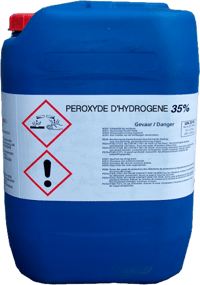When you think about toxic substances, do you imagine billowing clouds of industrial chemicals polluting our atmosphere, or perhaps the poisoning of waterways and oceans from pesticides and runoff?
The first images that spring to mind may not be the chemicals that clean your bathroom with or the packaging you receive when you pick up your take-away order. However, toxic substances are commonly found in everyday products such as household cleaning chemicals, packaging, furniture, toys, cosmetics, prescription drugs, alcohol and backyard pesticides. They are also found in environmental pollutants such as the emissions from your petrol- or diesel-powered vehicle.

The average person will encounter many toxic substances without even leaving their home. In fact, any chemical that can cause harm to human health when it enters the body is regarded as a toxic substance. Of course, many of the everyday items that we use contain small amounts of toxic chemicals that won’t adversely affect our health. But if you’re working with toxic chemicals, your workplace needs to minimise the serious risks that toxic substances pose to human health.
In this blog, we look at the dangerous properties of toxic substances, their impact on human health and how you can store toxic substances in a compliant manner.
Definition Of Toxic Substances
The Australian Dangerous Goods Code (ADG code) classifies these chemicals as Class 6, Division 6.1 Toxic Substances.
The ADG Code also details the definition of toxic substances:
Division 6.1 Toxic Substances - These are substances liable either to cause death or serious injury or to harm human health if swallowed or inhaled or by skin contact.
What Are The Health Risks?
There are three ways that toxic substances can enter the human body:
- Inhalation
- Skin absorption
- Ingestion
They can cause acute effects (which present immediately upon exposure) and chronic effects (which may take months or years to present symptoms).
Inhalation is the most common form of toxic chemical exposure. It occurs when personnel are in contact with airborne toxic substances. Inhaling toxic chemicals can induce intoxication very quickly, leading to both acute and chronic effects. Inhalation can irritate your respiratory tract as well as your eyes, nose and throat. Vapours can cause a range of health issues from nausea, dizziness and drowsiness to unconsciousness and death.
 Toxic Chemical Health Risks
Toxic Chemical Health Risks
Skin absorption is another health risk associated with working with toxic substances, which can cause serious health problems. Some toxic substances, such as organic solvents and organic pesticides, can be quickly absorbed through your skin and enter your bloodstream. Even a small amount of toxic chemicals accidently splashed onto the skin or splattered onto clothing can cause acute health effects for personnel.
Ingestion is the least common form of toxic substance exposure. It can occur in workplaces when personnel accidently consume toxic substances— such as drinking from an incorrectly labelled bottle which contains toxic chemicals. Ingestion can be in the form of drinking, eating or smoking toxic substances.
Acute effects of toxic chemical exposure usually present themselves immediately. These effects can include headaches, nausea, vomiting, skin irritation and more. Chronic effects are the result of long-term exposure to toxic substances and can appear months and years after the initial exposure. Diseases which are caused by long-term exposure may include life-threatening illnesses such as cancer and lung disease.
What Are Some Common Toxic Substances?
There are many toxic substances that are commonly found in Australian workplaces and laboratories. Examples of toxic substances include methylene chloride, hydrogen peroxide and Sodium Azide.
- Methylene chloride is a colourless solvent that has a sweet odour. This chemical can cause harm to the central nervous system and irritation to your eyes and skin upon exposure. Methylene chloride can also immediately induce headaches, nausea, dizziness and drowsiness. These symptoms have a severe effect on your coordination. High exposure to methylene chloride can result in death.
- Hydrogen peroxide is an oxidising agent with toxic properties. It is a very common toxic substance which is used as a bleaching agent, antiseptic and oxidiser. If hydrogen peroxide vapours are inhaled, it can cause severe pulmonary irritation. If it is ingested, it may induce vomiting, stomach aches and gastric distension. If this chemical is ingested in high concentrations it can be life-threatening.

- Sodium Azide is a rapidly-acting toxic substance that is commonly used as a chemical preservative in laboratories and hospitals. This chemical is a toxic skin irritant that can cause a range of health issues including low blood pressure, headaches and heart failure. If sodium azide is swallowed, inhaled or comes into contact with skin, it can result in a fatality.
What Are Toxic Substances Storage Requirements?
Safe storage is an important element of keeping everyone in the workplace safe from toxic chemicals. In Australia and New Zealand, the requirements for safe and compliant storage of toxic substances is found in the Australia Standard AS NZS 4452-1997 The Storage and Handling of Toxic Substances.
The standard details the types and quantities of toxic substances that can be stored indoors at any one time:
4.1.1 Requirements specifically for indoor storage cabinets
4.1.1.1 Types of substances kept Cabinets designated for the storage of packages of toxic substances shall not be used for the storage of goods that are incompatible, or that react dangerously.
4.1.1.2 Maximum quantities to be kept The maximum quantity of toxic substances kept in a single cabinet shall not exceed 250 kg or 250 L, of which not more than 50 kg or 50 L shall be of Packing Group II and not more than 25 kg or 25 L shall be of Packing Group I.
NOTE: Units of kilograms are applicable to solids and units of litres to liquids.
AS NZS 4452-1997 specifies 250 L/Kg as the maximum quantity of toxic substances to be kept inside a single cabinet and explains that cabinets should not be used for incompatible dangerous goods.
Incompatible Substances
When indoor toxic storage cabinets are used for the storage and handling of toxic substances, they must be installed in a location that is well away from any incompatible substances. Incompatible substances will react dangerously and cause harm to people property and the environment. For information on how to segregate incompatible classes of dangerous goods, refer to the dangerous goods segregation guide.
Features Of A Compliant Toxic Storage Cabinet
Section 4 of AS NZS 4452-1997 sets out the requirements for the storage and handling of packages containing toxic substances.
This includes the specific requirements for the construction of indoor toxic storage cabinets including wall thickness, closing mechanism specifications, shelf design, ventilation, sump capacity and signage.
There are several features of a compliant storage cabinet that make them an effective hazard minimisation measure for workplaces using toxic substances.
The features of a compliant toxic storage cabinet include:
- Double-walled sheet steel construction
- Self-closing, self-latching doors
- Perforated shelves
- Liquid-tight sump
Cabinet Design
The Australian Standard AS NZS 4452-1997 clearly states the requirements for toxic substance indoor storage cabinets:
4.4.2 Requirements specifically for indoor storage cabinets
4.4.2.3 Cabinet design The following requirements apply to the design of cabinets:
- The walls, floor, door and roof shall be of double walled sheet steel construction,
having a thickness of at least 0.75 mm, with a space at least 40 mm between the walls, which may be either an airspace or filled with non-combustible insulation. - Cabinets shall be provided with a self-closing, close-fitting door.
- Cabinets for the storage of toxic substances shall be lockable.
- The cabinet bottom shall form a liquid-tight compound at least 150 mm deep
and capable of containing at least 25% of the maximum storage capacity. - Any shelves in cabinets shall be designed to permit free air movement.
- The materials of any components that are critical to structural integrity shall not melt at temperatures of less than 850°C, seals or gaskets excepted.
To summarise the standard, the design of toxic storage cabinets must include lockable self-closing self-latching doors, perforated shelves to allow for free air movement and a liquid-tight sump. The sump (the area used to contain spills within the cabinet) of the cabinet must be 150mm deep and capable of containing at least 25% of the cabinet’s maximum storage capacity.
All sides of the toxic storage cabinet - walls, floor, door and roof - must have a double-walled sheet steel construction. The sheet used to construct the walls must be at least 0.75mm thick.
The space between the sheets must be an open-air space or filled with a non-combustible insulation. The main construction of the cabinet must be resistant to melting at temperatures of up to 850 ºC — however, this doesn’t include components such as seals and gaskets.
Ventilation Of Toxic Storage Cabinets
While AS NZS 4452-1997 does not make ventilation of toxic storage cabinets a mandatory requirement, if the concentration of airborne contaminants within the cabinet is above the workplace exposure standards, ventilation will be required.
Where a ventilation system is installed, it is important that the system doesn’t compromise the structural integrity of the cabinet. Toxic cabinet ventilation systems should be designed by an appropriately qualified engineer.
Where To Position Your Toxic Storage Cabinet
The Australian Standards also specifies that no more than one 250 L toxic storage cabinet is used in each 100 m2 of workshop floor space. The separation distance between any two toxic storage cabinets shall be at least 3m.
When choosing a position for your toxic storage cabinet, it is vital that you select a position that is both close to a hand washing facility and far away from emergency exits and stairwells. This positioning enables personnel to quickly access the hand washing facility. It also allows the free movement of emergency teams entering the building — as well as personnel exiting the building — in the event of an emergency.
Are Your Toxic Substances Stored Safely?
When you can identify toxic substances in your workplace and understand their chemical and physical properties, you can take proactive measures to reduce the risk that they pose to the health of your staff. There are many types of toxic substances commonly found in workplaces, so it’s crucial that you segregate them from other incompatible dangerous goods. If you’d like to learn more about safely storing toxic substances, please download our free eBook How Segregate Different Classes Of Dangerous Goods by clicking on the image below.
Joining the team as a Dangerous Goods Storage Consultant, Melissa Hampton became Storemasta's Marketing Manager in late 2021. With extensive knowledge and experience in chemical compliance, Melissa is responsible for leading the Marketing team and helping shape their marketing strategy. In her spare time, you can find Melissa hiking, swimming and enjoying the great outdoors in beautiful north-west Tasmania.
